财务会计理论(SCCOT)第四章有效证券市场
财务会计理论(第7版)课件:有效证券市场

>> Continued
4-4
价格的信息含量 (续)
• 避免逻辑不一致的方法
– 噪声交易
• 噪声预期值 = 0 • 股价仍然有效,但在预期价值意义上
– 在噪声交易的情况下,股价具有部分信息含量
• 噪声交易可能导致股价偏离其有效价值 • 恢复投资者收集信息的动机
– 低估计风险,尽可能接近公司的基本价值的股价是有成本效 率的。
4 - 13
估计风险图示
4 - 14
4.7 正常运转的证券市场的社会意义
• 在资本主义经济中,将稀缺资本分配给竞争的需求方是通 过市场价格实现的。
– 拥有生产性资本项目的公司应该得到高股价(低资本成本)的回报, 反之亦然
• 如果股价反映基本价值,资本配置是最有效的
• 有效性是理论上的理想
– 第6章讨论了实际证券市场与这一理想有多接近的问题
4-2
4.3 有效证券市场对财务报告的意义
• W.H.Beaver论文《FASB的目标应该是什么?》 Journal of Accountancy (1973)
– 完全披露,包括会计政策 – 会计政策无关紧要(除非现金流量影响) – “天真”的投资者受到价格保护 – 会计人员与其他信息提供者的竞争
– 股价越接近基本价值(即如果市场运行良好),社会越富裕
» Continued
4 - 15
正常ห้องสมุดไป่ตู้转的证券市场的社会意义 (续)
• 财务报告的社会作用
– 帮助市场运行良好
• 最大化公开信息量 • 受成本效益约束
• 证券市场有效性提高了财务报告的社会作用
财务理论
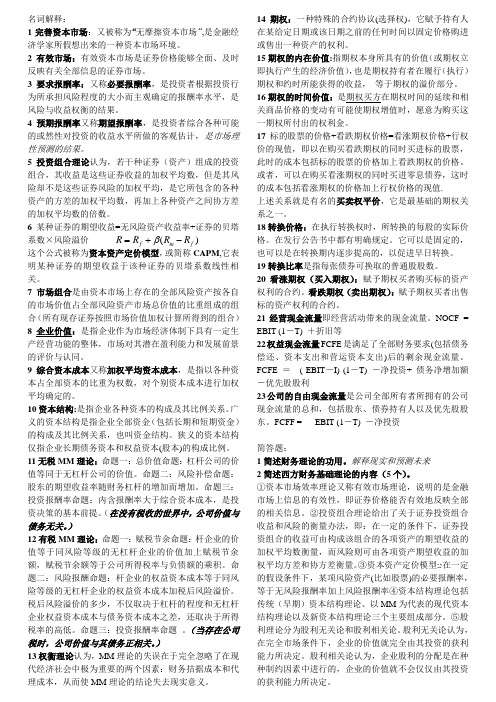
名词解释:1完善资本市场:又被称为“无摩擦资本市场”,是金融经济学家所假想出来的一种资本市场环境。
2有效市场:有效资本市场是证券价格能够全面、及时反映有关全部信息的证券市场。
3要求报酬率:又称必要报酬率,是投资者根据投资行为所承担风险程度的大小而主观确定的报酬率水平,是风险与收益权衡的结果。
4预期报酬率又称期望报酬率,是投资者综合各种可能的或然性对投资的收益水平所做的客观估计,是市场理性预测的结果。
5投资组合理论认为,若干种证券(资产)组成的投资组合,其收益是这些证券收益的加权平均数,但是其风险却不是这些证券风险的加权平均,是它所包含的各种资产的方差的加权平均数,再加上各种资产之间协方差的加权平均数的倍数。
6某种证券的期望收益=无风险资产收益率+证券的贝塔系数×风险溢价 这个公式被称为资本资产定价模型,或简称CAPM ,它表明某种证券的期望收益于该种证券的贝塔系数线性相关。
7市场组合是由资本市场上存在的全部风险资产按各自的市场价值占全部风险资产市场总价值的比重组成的组合(所有现存证券按照市场价值加权计算所得到的组合) 8企业价值:是指企业作为市场经济体制下具有一定生产经营功能的整体,市场对其潜在盈利能力和发展前景的评价与认同。
9综合资本成本又称加权平均资本成本,是指以各种资本占全部资本的比重为权数,对个别资本成本进行加权平均确定的。
10资本结构:是指企业各种资本的构成及其比例关系。
广义的资本结构是指企业全部资金(包括长期和短期资金)的构成及其比例关系,也叫资金结构。
狭义的资本结构仅指企业长期债务资本和权益资本(股本)的构成比例。
11无税MM 理论:命题一:总价值命题:杠杆公司的价值等同于无杠杆公司的价值。
命题二:风险补偿命题:股东的期望收益率随财务杠杆的增加而增加。
命题三:投资报酬率命题:内含报酬率大于综合资本成本,是投资决策的基本前提。
(在没有税收的世界中,公司价值与债务无关。
)12有税MM 理论:命题一:赋税节余命题:杆企业的价值等于同风险等级的无杠杆企业的价值加上赋税节余额,赋税节余额等于公司所得税率与负债额的乘积。
财务会计理论(SCCOT)第四章有效证券市场
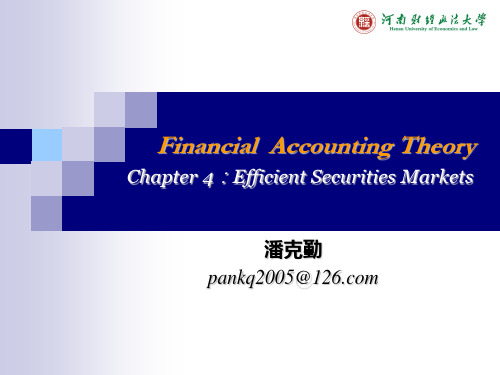
In other words, in an efficient market at any point in time the actual price of a security will be a good estimate of its intrinsic value."
History
Prior to the 1950’s it was generally believed that the use of fundamental or technical approaches could “beat the market” (though technical analysis has always been seen as something akin to voodoo).
They also found that stock prices reacted to new information almost instantly, not gradually as had been believed.
财务会计理论 第四章
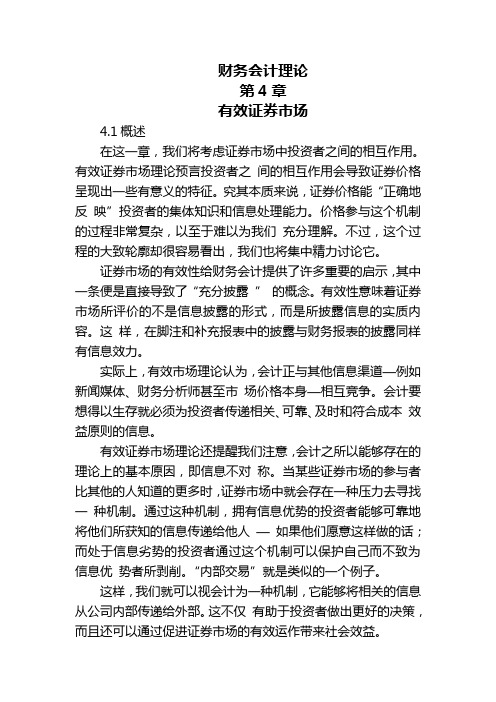
财务会计理论第4章有效证券市场4.1概述在这一章,我们将考虑证券市场中投资者之间的相互作用。
有效证券市场理论预言投资者之间的相互作用会导致证券价格呈现出一些有意义的特征。
究其本质来说,证券价格能“正确地反映”投资者的集体知识和信息处理能力。
价格参与这个机制的过程非常复杂,以至于难以为我们充分理解。
不过,这个过程的大致轮廓却很容易看出,我们也将集中精力讨论它。
证券市场的有效性给财务会计提供了许多重要的启示,其中一条便是直接导致了“充分披露”的概念。
有效性意味着证券市场所评价的不是信息披露的形式,而是所披露信息的实质内容。
这样,在脚注和补充报表中的披露与财务报表的披露同样有信息效力。
实际上,有效市场理论认为,会计正与其他信息渠道—例如新闻媒体、财务分析师甚至市场价格本身—相互竞争。
会计要想得以生存就必须为投资者传递相关、可靠、及时和符合成本效益原则的信息。
有效证券市场理论还提醒我们注意,会计之所以能够存在的理论上的基本原因,即信息不对称。
当某些证券市场的参与者比其他的人知道的更多时,证券市场中就会存在一种压力去寻找一种机制。
通过这种机制,拥有信息优势的投资者能够可靠地将他们所获知的信息传递给他人—如果他们愿意这样做的话;而处于信息劣势的投资者通过这个机制可以保护自己而不致为信息优势者所剥削。
“内部交易”就是类似的一个例子。
这样,我们就可以视会计为一种机制,它能够将相关的信息从公司内部传递给外部。
这不仅有助于投资者做出更好的决策,而且还可以通过促进证券市场的有效运作带来社会效益。
总的来说,财务会计准则制定组织已经接受了“充分披露”的方法。
为了对此予以解释,我们将从“信息观”的角度来考察近来两个相关的会计准则。
4.2 有效证券市场4.2.1 有效性的含义在第3章,我们研究了理性投资者的最优投资决策。
现在,我们将考虑当大量的理性投资者在证券市场上相互作用时会有什么情况发生。
我们所感兴趣的是参与市场交易的证券的市场价格特征,以及这些价格是如何为新的信息所影响。
威廉斯科特Scott财务会计理论(第七版)全套PPT课件
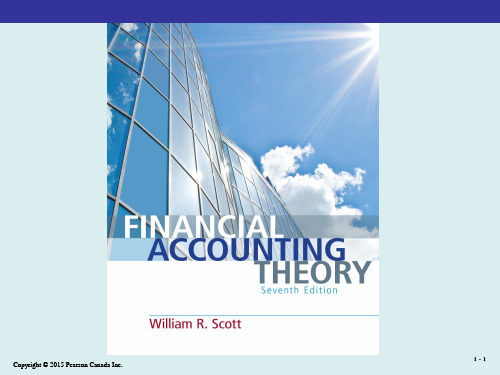
1-4 Copyright © 2015 Pearson Canada Inc.
1.2 Collapse of the Stock Market Boom of Late 1990s
• Enron • WorldCom • Collapse of public confidence in capital markets • Effects on financial reporting
– Liquidity risk
• Liquidity pricing
– Counterparty risk
>> Continued
1-6 Copyright © 2015 Pearson Canada Inc.
Market Meltdowns, 2007-2008 (continued)
• Financial accounting issues leading up to the market meltdowns
• Off-balance sheet liabilities • Use of expected loss notes to avoid consolidation of
structured investment vehicles • Was disclosure of off-balance sheet liabilities adequate?
盈余管理分析

盈余管理分析盈余管理分析摘要:盈余管理就是企业管理当局在遵循会计准则的基础上,通过对企业对外报告的会计收益信息进行控制或调整,以达到主体自身利益最大化的行为。
实施盈余管理主要有六种动因,两大类方法。
其本身具有四个特点。
可以通过加强研究合理规范来去弊存利。
关键词:盈余管理涵义动因方法特点一、盈余管理的涵义对于什么是盈余管理,至今并无定论。
美国会计学者斯考特(Scott)《财务会计理论》中指出:盈余管理是会计政策的选择具有经济后果的一种具体表现。
Paul M. Healy and James M.Wahlen(1999)提出:盈余管理使为了误导股东对公司潜在经济业绩的理解,或影响基于报告的会计数据的契约的结果,在编制财务报告和构造交易事项以改变财务报告时做出的判断过程. William J. Bruns, Kenneth A. Merchant认为:盈余管理包括会计操纵和经营操纵两个层面。
在会计政策许可的范围内,在构造业务交易和编制财务会计报告时作出职业判断和会计选择目前我国普遍认为:盈余管理就是企业管理当局为了自身的利益或为了使股东财富最大化的会计行为。
二、盈余管理的动因和条件1.盈余管理的根本原因是企业管理当局与利益相关者(包括股东、债权人、职工、客户等)之间利益的不一致。
.实施盈余管理主要有以下目的:一是管理当局完成委托代理契约;二是筹资目的,达到上市或配股的要求;三是合理避税;四是获取政治成本,使企业通过面临的与会计数据明显正相关的严格管制和监控;五是规避债务契约约束;六是企业高层管理人员的更迭。
2.盈余管理的条件:委托代理契约的不完全性(人们的认识水平,成本的约束等);会计准则,会计制度的不完善性(制度的空缺,可选择空间较大),信息的不对称性,现行会计理论和会计方法的固有缺陷(如权责发生制的确认标准,重要性和稳健性原则应用,会计估计的大量存在等)三、盈余管理的方法盈余管理主要是借助于会计政策的选择来实现的,但又不仅限于会计方法。
CEO变更与盈余管理--基于PSM和DID方法的分析
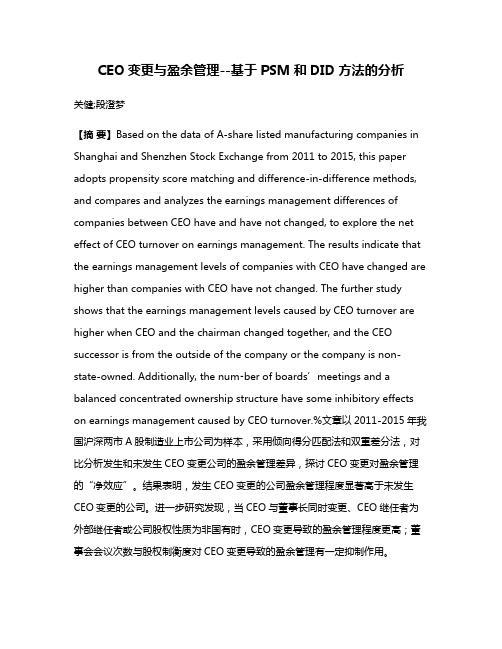
CEO变更与盈余管理--基于PSM和DID方法的分析关健;段澄梦【摘要】Based on the data of A-share listed manufacturing companies in Shanghai and Shenzhen Stock Exchange from 2011 to 2015, this paper adopts propensity score matching and difference-in-difference methods, and compares and analyzes the earnings management differences of companies between CEO have and have not changed, to explore the net effect of CEO turnover on earnings management. The results indicate that the earnings management levels of companies with CEO have changed are higher than companies with CEO have not changed. The further study shows that the earnings management levels caused by CEO turnover are higher when CEO and the chairman changed together, and the CEO successor is from the outside of the company or the company is non-state-owned. Additionally, the num⁃ber of boards’meetings and a balanced concentrated ownership structure have some inhibitory effects on earnings management caused by CEO turnover.%文章以2011-2015年我国沪深两市A股制造业上市公司为样本,采用倾向得分匹配法和双重差分法,对比分析发生和未发生CEO变更公司的盈余管理差异,探讨CEO变更对盈余管理的“净效应”。
《财务管理》第四章

证券公司 投资银行 信托投资公司 保险公司 财务公司
(三)金融政策
1、货币政策:是中央银行调整货币总需求的方针策 略。主要的货币政策工具有法定准备金率、贴现率、
公开市场业务。
2、利率政策:是央行根据货币供求关系而制定的一系 列利率水平。是我国中央银行实现货币政策目标的重 要手段之一。
银行吸收存款,集聚社会资本
3)预计留存收益增加额
假设该公司股利支付率为30%,销售净利率与上年 相同(136÷3000=4.5%)
留存收益增加额=4000×4.5%×(1-30%) =126(万元)
4)计算外部融资需求 外部融资需求=预计资产总额-预计负债总额
-预计股东权益合计
=2666.4-1121.8 -1066 =478.6(万元) 该公司为完成销售额4000万元,需要增加资金666.4 (2666.4-2000)万元,负债的自然增长提供61.8万元 [(234.8 -176) +(12-9)],留存收益提供126万元, 本年应向外再筹资478.6(666.4-61.8-126)万元。
2、模型: y=a+bx
式中:y--资本需求量 x --产销量 b--单位业务量所需要的可变资本额 a--不变资本总额 3、模型应用:P.159
思考题
1、企业筹资的动机对企业筹资行为及其结果有 何影响?
2、试分析企业筹资渠道和筹资方式的匹配关系。 3、试分析股权资本与债权资本的各自构成和特
性。 4、试说明销售百分比法的基本依据及其应用。
根据销售增加额确定筹资需求
1)确定外部筹资额与销售增长的关系
它是指销售额每增加1元需要追加的外部融资额。
公式:外部融资额=(上年实际敏感资产销售百分比
×新增销售额)-净利率×销售额×(1-股利支 付率)]
会计、有效市场假说

会计学原理案例分析
案例分析
2
请解释上述法案如果通过会对投资者如何有利?
经济社会最大的价值在未来(汉弗莱)。证券本身并无价值,其价值体现在其所 代表的企业的未来价值上。而企业的未来价值是通过上市公司对外公布的财务会 计信息反映的,尤其是财务预测信息,与一般的会计信息相比,它更具决策相关性, 上市公司财务预测信息的披露可以降低信息使用者与公司管理当局之间的信息不 对称程度,降低社会交易费用,是公众公司与投资者和社会公众沟通的“桥梁”。 因此,应加强财务预测信息披露的准确性与科学性,以预示和研判风险,更真实地呈 现证券的内在价值、金融工具及其衍生品的面貌, 有助于投资者从长远角度了解 公司,帮助投资者做出更加准确的判断和决策,降低投资者预期报酬落空的风险 性,弥补现行财务报告的不足,提高财务报告的有效性,这有助于抵御金融危机, 减少其带来的不利影响。
会计学原理案例分析
LOGO
谢谢倾听!
Байду номын сангаас
LOGO
会计学原理案例分析
全西西 2015.4.13
Contents
1 2 3
有效市场假说 市场有效性与财务会计领域的关系 有效市场假说对会计准则的影响
4
案例分析
会计学原理案例分析
有效市场假说
一、有效市场假说的提出 1970年,法玛提出了有效市场假说 (efficientmarketshypothesis),其对有效市场 的定义是:如果在一个证券市场中,价格完全反 映了所有可以获得的信息,那么就称这样的市场 为有效市场。 衡量证券市场是否具有外在效率有两个标志: (一)是价格是否能自由地根据有关信息而变动; (二)是证券的有关信息能否充分地披露和均匀 地分布,使每个投资者在同一时间内得到等量等 质的信息。
《财务会计理论》scott英文参考文献
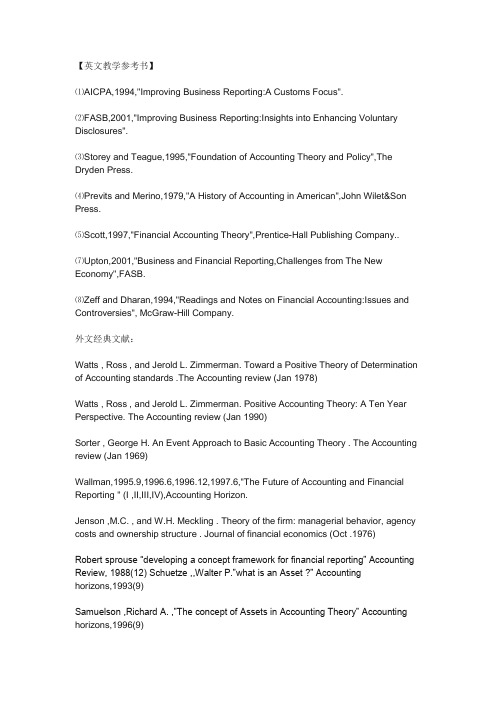
【英文教学参考书】⑴AICPA,1994,"Improving Business Reporting:A Customs Focus".⑵FASB,2001,"Improving Business Reporting:Insights into Enhancing Voluntary Disclosures".⑶Storey and Teague,1995,"Foundation of Accounting Theory and Policy",The Dryden Press.⑷Previts and Merino,1979,"A History of Accounting in American",John Wilet&Son Press.⑸Scott,1997,"Financial Accounting Theory",Prentice-Hall Publishing Company..⑺Upton,2001,"Business and Financial Reporting,Challenges from The New Economy",FASB.⑻Zeff and Dharan,1994,"Readings and Notes on Financial Accounting:Issues and Controversies", McGraw-Hill Company.外文经典文献:Watts , Ross , and Jerold L. Zimmerman. Toward a Positive Theory of Determination of Accounting standards .The Accounting review (Jan 1978)Watts , Ross , and Jerold L. Zimmerman. Positive Accounting Theory: A Ten Year Perspective. The Accounting review (Jan 1990)Sorter , George H. An Event Approach to Basic Accounting Theory . The Accounting review (Jan 1969)Wallman,1995.9,1996.6,1996.12,1997.6,"The Future of Accounting and Financial Reporting " (I ,II,III,IV),Accounting Horizon.Jenson ,M.C. , and W.H. Meckling . Theory of the firm: managerial behavior, agency costs and ownership structure . Journal of financial economics (Oct .1976)Robert sprouse “developing a concept framework for financial reporting” Accounting Review, 1988(12) Schuetze ,,Walter P.”what is an Asset ?” Accountinghorizons,1993(9)Samuelson ,Richard A. ,”The concept of Assets in Accounting Theory” Accounting horizons,1996(9)AAA ,”American Accounting Association on Accounting and Auditing Measurement:1989-1990” Accounting Horizons 1991(9)L.Todd Johnson and Kimberley R.Petrone “Is Goodwill an Asset?” Accounting Horizons1998(9)Linsmeier, Thomas J. and Boatsman ,Ja mes R. ,”AAA’s financial accounting standard response to IASC ED60 intangible assets” Accounting Horizons 1998(9)Linsmeier, Thomas J. and Boatsman,JamesR.”Response to IASC ExposureDraft ,’Provisions,Contingent Liabilities and Contingent Assets’ ” Accoun ting Horizons1998(6)L.Todd Johnson and Robert. Swieringa “derivatives, hedging and comprehensive income” Accounting Horizons 1996(11)Stephen A. .Zeff ,”The Rise of Economics Concequences”, The Journal of Accountancy 1978(12)David Solomons “the FASB’s Conceptual Framework:An Evaluation ” The Journal of Accountancy 1986(6)Paul Miller , “Conceptual Framework:Myths or Realities” The Journal of Accountancy 1985(3)Part I Financial Accounting TheorySuggested Bedtime Readings:1. C.J. Lee, Lecture Note on Accounting and Capital Market2. R. Watts and J. Zimmerman: Positive Accounting Theory3. W. Beaver: Revolution of Financial ReportingAlthough these three books are relatively "low-tech" in comparison with the reading assignments, but they provide much useful institutional background to the course. Moreover, these books give a good survey of accounting literature, especially in the empirical area.1. Financial Information and Asset Market Equilibrium*Grossman, S. and J. Stiglitz, "On the Impossibility of Informationally EfficientMarkets," American Economic Review (1980), 393-408.*Diamond, D. and R. Verrecchia, "Information Aggregation in a Noisy Rational Expectations Economy," Journal of Financial Economics, (1981), 221-35.*Milgrom, P. "Good News and Bad News: Representation Theorems and Applications," Bell Journal of Economics, (1981): 380-91.Grinblatt, M. and S. Ross, "Market Power in a Securities Market with Endogenous Information," Quarterly Journal of Economics, (1985), 1143-67.2. Financial Disclosure* Verrecchia, R. "Discretionary Disclosure," Journal of Accounting and Economics (1983),179-94.2Dye, R., "Proprietary and Nonproprietary Disclosure," Journal of Business, 59 (1986), 331-66.Dye, R., "Mandatory Versus Voluntary Disclosures: The Cases of Financial and Real Externalities," Accounting Review, (1990), 1-24.Bhushan, R., "Collection of Information About Public Traded Firms: Theory and Evidence," Journal of Economics and Accounting, (1989), 183-206.Diamond, D. "Optimal Release of Information by Firms," Journal of Economic Theory (1985), 1071-94.Verrecchia, R. "Information Quality and Discretionary Disclosure," Journal of Accounting and Economics, 1990.Trueman, B. "Theories of Earnings-announcement Timing," Journal of Accounting and Economics, 13 (1990), 1-17.Joh, G. and C. J. Lee "Timing of Financial Disclosure in Oligopolies," mimeo.* Joh, G. and C. J. Lee "Stock Market Reactions to Accounting Information in Oligopoly," Journal of Business, 1992.Darrough, M.N. and N.M. Stoughton, "Financial Disclosure Policy in an Entry Game," Journal of Accounting and Economics, (1990), 219-243.Wagenhofer, A. "Voluntary Disclosure with a Strategic Opponent," Journal of Accounting and Economics, 12 (1990), 341-363.Chang, C. and C.J. Lee, "Information Acquisition as a Business Strategy," Southern Economic Journal, 1992.Chang, C. and C.J. Lee, "Optimal Pricing Strategy in Marketing Research Consulting," International Economic Review, May 1994.Chang, C. and C.J. Lee, "Selling Proprietary Information to Rivaling Clients," mimeo.3. Earnings Manipulation and Accounting Choice* Watts, R. and J. Zimmerman,"Toward a Positive Theory of the Determination ofAccounting Standards," Accounting Review, January 1978, pp.112-34.*Healy, P.M. "The Effect of Bonus Schemes on Accounting Decisions" Journal of Accounting and Economics, April 1985, 85-108.*Chen, K. and C.J. Lee, "Executive Bonus Plans and Accounting Trade-off: The Case of the 3Oil and Gas Industry, 1985-86," Accounting Review, January, 1995.*Lee, C.J. and D. Hsieh, "Choice of Inventory Accounting Methods: A Test of Alternative Hypotheses," Journal of Accounting Research, Autumn 1985.*Lee, C.J. and C.R. Petruzzi, "Inventory Accounting Switch and Uncertainty", Journal of Accounting Research, Autumn 1989.*Chau, D. and C.J. Lee, “Big Bath and Dress Up in the Process of Chapter 11 Restructuring,” working paper.*Aharony, J., C.J. Lee, and T.J. Wong, “Financial Packaging of IPO Firms in China” Journal of Accounting Research, Spring 2000.Gu, Z. and C.J. Lee, “How Widespread is Earnings Management? A Measurement Based on Seasonal Heteroscedasticity.” working paperGu, Z. and C.J. Lee, “Cross-sectional Heteroscedasticity of Accounting Accruals,” working paper.Holthausen, R.W. and R.W. Leftwich, "The Economic Consequences of Accounting Choice: Implications of Costly Contracting and Monitoring," Journal of Accounting and Economics, August 1983, PP. 77-118.Moyer, S.E. "Capital Adequacy Ratio Regulations and Accounting Choices in Commercial banks," Journal of Accounting and Economics, (1990), 123-154.Blacconiere, W.G., R.M. Bowen, S.E. Sefcik, and C.H. Stinson, "Determinants of the Use of Regulatory Accounting Principles by Savings and Loans," Journal of Accounting and Economics, (1991) 167-202.Hand, J.R.M. and P.J. Hughes, and S.E. Sefcik, "Insubstance Defeasances," Journal of Accounting and Economics, (1990), 47-89.Duke, J.C. and H.G. Hunt III, "An Empirical Examination of Debt Covenant Restrictions and Accounting-Related Debt Proxies," Journal of Accounting and Economics, 12 (1990), 45-64.Malmquist, D.H., "Efficient Contracting and the Choice of Accounting Method in the Oil and Gas Industry," Journal of Accounting and Economics, 12 (1990), 173-207.Holthausen, R.W., "Accounting Method Choice: Opportunistic Behavior, Efficient Contracting, and Information Perspectives," Journal of Accounting and Economics, 12 (1990), 207-218.Watts, R. L. and J. L. Zimmerman, Positive Accounting Theory, Prentice Hall, 1985, Chapters 7-15.44. Measurement and Valuation Role of Accounting*Ball, R. and P. Brown, “Empirical Evaluation of Accounting Income Numbers,” Journal of Accounting Research, 1968.*Lee, C.J. and A. Li, “Risk, Contrarian Strategies, and Analysts’ Over-reaction: A Study of B/M and E/P Anomaly in Cross-sectional Returns.” Working Paper.Lee, C.J. "Inventory Accounting and Earnings/Price Ratios: A Puzzle," Contemporary Accounting Research, Fall, 1988.Chen, K. and C.J. Lee, "Accounting Measurement of Economic Performance and Tobin's q Theory," Journal of Accounting, Auditing, and Finance, Spring, 1995.Gu, Z. and C.J. Lee, "Co-integration and Test of Present Value Model: A Revisit," mimeo.Ghosh, A. and C.J. Lee, "Accounting Information and Market Valuation of Takeover Premium," Financial Management, Forthcoming* Joh, G. and C. J. Lee "Stock Market Reactions to Accounting Information in Oligopoly," Journal of Business, 1992.Part II Managerial Accounting5. Agency Theory*Holmstrom, B. "Moral Hazard and Observability," Bell Journal of Economics, (1979), 74-91Rogerson, "The First Order Approach to Principal-Agent Problems," Econometrica, March 1985.*Jesen, M. and W. Meckling, "Theory of the Firm, Managerial Behavior, Agency Costs and Ownership Structure," Journal of Financial Economcs, (1976), 305-60.*Grossman, S. and O. Hart, "An Analysis of the Principal-Agent Problem," Econometrica, (1983), 7-46.Holmstrom, B. "Moral Hazard in Teams," Bell Journal of Economics, (1982), 224-40.Milgrom, P. and J. Roberts, "Relying on the Information of Interested Parties," The Rand Journal of Economics, (1986), 18-32.Malcomson, J. "Rank-order Contract for a Principal with Many Agents," Review of Eonomic Studies, (1986), 807-817.Lambert, R. "Long-term Contracts and Moral Hazard," Bell Journal of Economics, (1983),5.441-452.Malcomson, J. and F. Spinnewyn, "The Multiperiod Principal-Agent Problem," Review of Economic Studies, (1988), 391-408.6. Theory of Firm and Organization*Coase, R.H. "The Nature of the Firm," Economica, (1937), 386-405.*Alchian, A.A. "Uncertainty, Evolution and Economic Theory," Journal of Political Economy,(1950), 211-21.*Alchian, A.A. and H. Demsetz, "Production, Information Costs and Economic Organization," American Economic Review, (1972), 777-795.* Sah, R. and J. Stiglitz, "The Architecture of Economic Systems: Hierarchies and Polyarchies," American Economic Review (1986), 716-727Aoki, M. "Horizontal vs. Vertical Information Structure of the Firm," American Economic Review (1986), 971-983.Tirole, J. "Hierarchies and Bureaucracies," Journal of Law, Economics and Organization (1986), 181-214.Christensen, J. "Communication in Agencies," Bell Journal of Economics, (1981), 661-674.Grossman, S. and O. Hart, "The Costs and Benefits of Ownership: A Theory of Vertical and Horizontal Integration," Journal of Political Economy, (1986), 691-719.Mookherjee, D. "Optimal Incentive Schemes with Many Agents," Review of Economic Studies (1984), 433-46.Demski, J. and D. Sappington, "Optimal Incentives with Multiple Agents," Journal of Economic Theory (1984), 152-71.Holmstrom, B. and J. Tirole, "The Theory of the Firm," in Handbook of Industrial Organization, 1990.Williamson, O. Markets and Hierarchies, 1975Williamson, O. The Economic Institution of Capitalism, 1985, Ch.6, 9, 11.7. Accounting and Internal Control*Demski, J. and D. Sappington, "Hierarchical Structure and Responsibility Accounting," Journal of Accounting Research, 1989.6*Coase, R.H., "Accounting and the Theory of Firm," Journal of Accounting and Economics, (1990), 3-13.Jordan, J., "The Economics of Accounting Information Systems," American Economic Review, 1989.Antle, R. and J. Fellingham, "Resource Rationing and Oganizational Slack in aTwo-Period Model," Journal of Accounting Research, (1990) 1-24.Demski, J., J. Patell, and M. Wolfson, "Decentralized Choice of Monitoring Systems," Accounting Review, (1984), 16-34.Penno, M. "Accounting Systems, Participation in Budgeting, and Performance Evaluation," Accounting Review, (1990), 303-314.Melumed, N.D. and S. Reichelstein, "Centralized vesus Delegation and the Value of Communication," Journal of Accounting Research, (1987 Supplement), 1-21.8. Field Studies of Management Accounting*Baiman, S., D.F. Larcker, and M.V. Rajan, "Organizational Design for Business Units," Journal of Accounting Research, 33 (Autumn 1995): 205-231.Lee, C.J. “Financial Restructuring of State-owned Enterprises in China: The Case of Shanghai Sunve Co.” Accounting, Organization and Society, fo rthcoming.Part 3. Auditing and Accounting Regulation9. Role of Auditing*R.A. Dye, B.V. Balachandran, and R.P. Magee, "Contingent Fees for Audit Firms," Journal of Accounting Research, (1990), 239-266.*L. DeAngelo, "Auditor Independence, 'Low Balling,' and Disclosure Regulation," Journal of Accounting and Economics, (1981), 113-27.*Lee, C.J. and Z. Gu, " Low Balling, Legal Liability and Auditor Independence,” Accounting Review, 1998.Magee, R.P. and M. Tseng, "Audit Pricing and Independence," Accounting Review, (1990), 315-336.Datar, S., G.A. Feltham, and J.S. Hughes, "The Role of Audits and Audit Quality in Valuing New Issues," Journal of Accounting and Economics, (1991), 3-50.7Penno, M. "Auditing for Performance Evaluation," Accounting Review, (1990),520-536.Melumad, N.D. and L. Thoman, "On Auditors and the Courts in an Adverse Selection Setting," Journal of Accounting Research, (1990) 77-120.Baiman, S., J.H. Evans III, and N.J. Nagarajan, "Collusion in Auditing," Journal of Accounting Research, (1991), 1-18.10. Financial Accounting Standards*Dye, R. and R.E. Verrecchia, "Discretion vs. Uniformity: Choices Among GAAP," Accounting Review, July 1995, 389-415.Farrell, J. and G. Saloner, "Standardization, Compatibility, and Innovation," Rand Journal of Economics. 16 (Spring 1985): 70-83.*Lev, B. "Toward a Theory of Equitable and Efficient Accounting Policy," Accounting Review, January 1988.11. The Market of CPAs*Dye, R. "Incorporation and the Audit Market," Journal of Accounting and Economics, 19 (1995): 75-114.*Lee, C.J., C. Liu, and T. Wang, “The 150 Hours Rule,” Journal of Accounting and Economics, 1999.Liu, C., C.J. Lee, and T. Wang, “Human Capital, Auditor Independence, and Legal Liability,” working paper.Riodan, M. and D. Sappington, "Information, Incentives, and Organizational Mode,"Quarterly Journal of Economics, 102 (1987): 243-264.*Gigler, F. and M. Penno, "Imperfect Competition in Audit Markets and its Effects on the Demand for Audit-Related Services," Accounting Review, 70 (April 1995):317-336.。
财务管理PPT课件第四章 证券价值评估
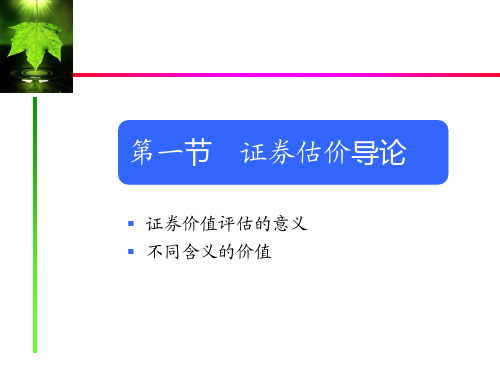
M
I
I
I
I
0
1
2
n
债券价值与折现率k
▪ 债券价值与投资者的必要收益率(即:当前市场 利率)呈反向变动关系。
债券 价值
债券票面:1000元,10%
1079.85 1000 927.90
8% 10% 12%
收益率
如果① 必要收益率k = 票面利息率
面值1000元 票面利息6%
▪ 假设每年股利按一稳定的比率g增长,则每期所 得到的股利就是一个等比数列。
▪ 各年股利折现的现值,就是稳定增长型永续年金 的现值。
股利增长模型推导
股利:D1 D0 (1 g)1,, Dn D0 (1 g)n,
V
D0 (1 g)1 (1 k)1
D0 (1 g)2 (1 k)2
D0 (1 g)3 (1 k)3
第一节 证券估价导论
▪ 证券价值评估的意义 ▪ 不同含义的价值
证券的不同价值
账面 价值
清算 价值
市场 价值
内在 价值
内在价值
▪ 内在价值:也称经济价值,是指以适当的收益率 对资产未来预期产生的现金流量折现所得到的现 值。
内在价值与市场价值的关系
▪ 如果证券市场是有效的,那么,证券的市场价值 就与其内在价值相等。
1 V
I (1 k
)1
2I (1 k
)2
3 I (1 k
)3
.....
(1 k )
]
nI (1 k )n
nM (1 k )n
1 V
n t 1
t FCt (1 k )t
债券的久期
dV
V dur
d(1 k)
第七版答案(翻译-英译中结果)
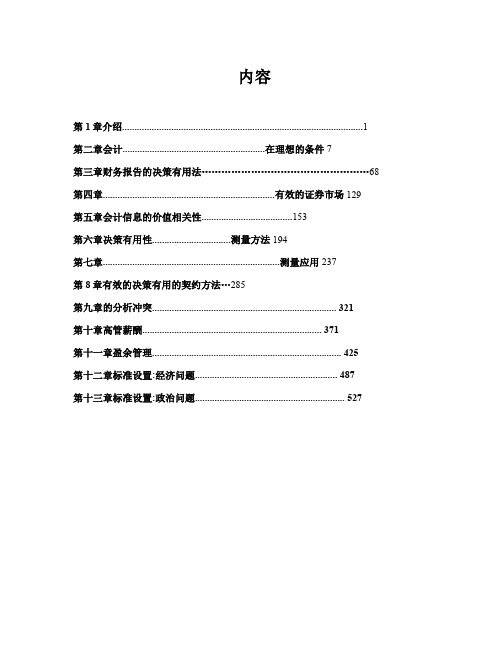
内容第1章介绍 (1)第二章会计..........................................................在理想的条件7第三章财务报告的决策有用法 (68)第四章......................................................................有效的证券市场129第五章会计信息的价值相关性 (153)第六章决策有用性................................测量方法194第七章........................................................................测量应用237第8章有效的决策有用的契约方法 (285)第九章的分析冲突 (321)第十章高管薪酬 (371)第十一章盈余管理 (425)第十二章标准设置:经济问题 (487)第十三章标准设置:政治问题 (527)版权©2015年皮尔森加拿大公司。
第一章介绍1.1 这本书的目的1.2 一些历史的角度来看1.3 2007-2008年的市场崩盘1.4 有效的合同1.5 关于道德行为的说明1.6 基于规则的与基于原则的会计准则1.7 财务会计和报告信息的复杂性1.8 会计研究的作用1.9 信息不对称的重要性1.10财务会计理论的基本问题1.11监管作为对根本问题的反应1.12本书的组织结构1.12.1理想条件1.12.2逆向选择1.12.3道德风险1.12.4标准设定1.12.5标准设定过程1.13财务会计理论与会计实务的相关性学习目标及建议教学方法1. 这本书的概要我使用图1.1作为模板来描述这本书的大致轮廓。
由于学生们通常没有机会在第一节课上阅读第一章,所以我非常关注这一章的内容。
我讨论的要点是:•理想的会计环境。
在这里,基于现值的会计是很自然的。
我讨论了这种会计基础可行所需的理想条件,但没有详细讨论,因为这个主题在第2章有更深入的讨论。
有效证券市场与财务会计理论
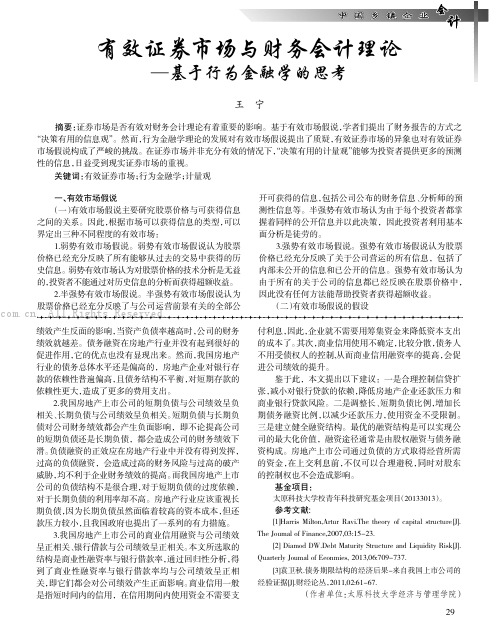
有效证券市场与财务会计理论—基于行为金融学的思考王宁摘要:证券市场是否有效对财务会计理论有着重要的影响。
基于有效市场假说,学者们提出了财务报告的方式之“决策有用的信息观”。
然而,行为金融学理论的发展对有效市场假说提出了质疑,有效证券市场的异象也对有效证券市场假说构成了严峻的挑战。
在证券市场并非充分有效的情况下,“决策有用的计量观”能够为投资者提供更多的预测性的信息,日益受到现实证券市场的重视。
关键词:有效证券市场;行为金融学;计量观一、有效市场假说(一)有效市场假说主要研究股票价格与可获得信息之间的关系。
因此,根据市场可以获得信息的类型,可以界定出三种不同程度的有效市场:1.弱势有效市场假说。
弱势有效市场假说认为股票价格已经充分反映了所有能够从过去的交易中获得的历史信息。
弱势有效市场认为对股票价格的技术分析是无益的,投资者不能通过对历史信息的分析而获得超额收益。
2.半强势有效市场假说。
半强势有效市场假说认为股票价格已经充分反映了与公司运营前景有关的全部公开可获得的信息,包括公司公布的财务信息、分析师的预测性信息等。
半强势有效市场认为由于每个投资者都掌握着同样的公开信息并以此决策,因此投资者利用基本面分析是徒劳的。
3.强势有效市场假说。
强势有效市场假说认为股票价格已经充分反映了关于公司营运的所有信息,包括了内部未公开的信息和已公开的信息。
强势有效市场认为由于所有的关于公司的信息都已经反映在股票价格中,因此没有任何方法能帮助投资者获得超额收益。
(二)有效市场假说的假设绩效产生反面的影响,当资产负债率越高时,公司的财务绩效就越差。
债务融资在房地产行业并没有起到很好的促进作用,它的优点也没有显现出来。
然而,我国房地产行业的债务总体水平还是偏高的,房地产企业对银行存款的依赖性普遍偏高,且债务结构不平衡,对短期存款的依赖性更大,造成了更多的费用支出。
2.我国房地产上市公司的短期负债与公司绩效呈负相关、长期负债与公司绩效呈负相关。
【资产评估师学霸笔记】有效市场理论
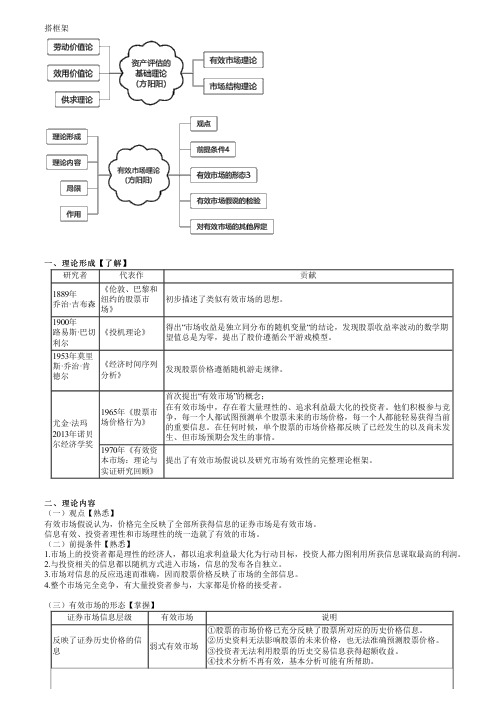
搭框架 一、理论形成【了解】一、理论形成【了解】研究者代表作贡献1889年乔治·吉布森《伦敦、巴黎和纽约的股票市场》初步描述了类似有效市场的思想。
1900年路易斯·巴切利尔《投机理论》得出“市场收益是独立同分布的随机变量“的结论,发现股票收益率波动的数学期望值总是为零,提出了股价遵循公平游戏模型。
1953年莫里斯·乔治·肯德尔《经济时间序列分析》发现股票价格遵循随机游走规律。
尤金·法玛2013年诺贝尔经济学奖1965年《股票市场价格行为》首次提出“有效市场”的概念;在有效市场中,存在着大量理性的、追求利益最大化的投资者。
他们积极参与竞争,每一个人都试图预测单个股票未来的市场价格,每一个人都能轻易获得当前的重要信息。
在任何时候,单个股票的市场价格都反映了已经发生的以及尚未发生、但市场预期会发生的事情。
1970年《有效资本市场:理论与实证研究回顾》提出了有效市场假说以及研究市场有效性的完整理论框架。
二、理论内容二、理论内容 (一)观点【熟悉】 有效市场假说认为,价格完全反映了全部所获得信息的证券市场是有效市场。
信息有效、投资者理性和市场理性的统一造就了有效的市场。
(二)前提条件【熟悉】 1.市场上的投资者都是理性的经济人,都以追求利益最大化为行动目标,投资人都力图利用所获信息谋取最高的利润。
2.与投资相关的信息都以随机方式进入市场,信息的发布各自独立。
3.市场对信息的反应迅速而准确,因而股票价格反映了市场的全部信息。
4.整个市场完全竞争,有大量投资者参与,大家都是价格的接受者。
(三)有效市场的形态【掌握】证券市场信息层级有效市场说明反映了证券历史价格的信息弱式有效市场①股票的市场价格已充分反映了股票所对应的历史价格信息。
②历史资料无法影响股票的未来价格,也无法准确预测股票价格。
③投资者无法利用股票的历史交易信息获得超额收益。
④技术分析不再有效,基本分析可能有所帮助。
- 1、下载文档前请自行甄别文档内容的完整性,平台不提供额外的编辑、内容补充、找答案等附加服务。
- 2、"仅部分预览"的文档,不可在线预览部分如存在完整性等问题,可反馈申请退款(可完整预览的文档不适用该条件!)。
- 3、如文档侵犯您的权益,请联系客服反馈,我们会尽快为您处理(人工客服工作时间:9:00-18:30)。
History
Prior to the 1950’s it was generally believed that the use of fundamental or technical approaches could “beat the market” (though technical analysis has always been seen as something akin to voodoo).
In the 1950’s and 1960’s studies began to provide evidence against this view.
In particular, researchers found that stock price changes (not prices themselves) followed a “random walk.”
2、财务会计的用武之地 充分披露,让证券价格接近内在价值,增强市 场配置资源的效率!
3、财务会计面临挑战 其他信息渠道
Definition of Efficient Markets
An efficient capital market is a market that is efficient in processing information.
Therefore, in an efficient market, prices immediately and fully reflect available information.
Definition of Efficient Markets (cont.)
Professor Eugene Fama, who coined the phrase “efficient markets”, defined market efficiency as follows:
"In an efficient market, competition among the many intelligent participants leads to a situation where, at any point in time, actual prices of individual securities already reflect the effects of information based both on events that have already occurred and on events which, as of now, the market expects to take place in the future.
In an informationally efficient market, the prices of securities observed at any time are based on “correct” evaluation of all information available at that time.
We are talking about an “informationally efficient” market, as opposed to a “transactionally efficient” market. In other words, we mean that the market quickly and correctly adjusts to new information.
The EMH Graphically
In this diagram, the circles represent the amount of information that each form of the EMH includes.
Note that the weak form covers the least amount of information, and the strong form covers all information.
They also found that stock prices reacted to new information almost instantly, not gradually as had been believed.
The Efficient Markets Hypothesis
The Efficient Markets Hypothesis (EMH) is made up of three progressively stronger forms: Weak Form Semi-strong Form Strong Form
Also note that each successive form includes the previous ones.
All historical prices and returns
Strong Form Semi-Strong Weak Form
Financial Accounting Theory
Chapter 4:Efficient Securities Markets
潘克勤 pankq2005@
本章的结构
有效性 财务报 的含义 告含义
模型
信息不对称/内 部交易、逆向
选择
充分 披露
本章的目的
1、证券市场是半强势有效的! 证券市场上每一种证券价格反映了已经公开的 所有信息 此时,证券价格就是内在价值吗? 否!除非没有内部信息!
